Strategic Planning in Tourism: Benefits and Development Analysis
VerifiedAdded on 2020/06/04
|14
|5009
|231
Report
AI Summary
This report delves into the significance of strategic planning within the tourism sector, outlining its benefits and various planning approaches. The introduction defines strategic planning as a crucial process for formulating strategies, allocating resources, and making decisions to achieve organizational goals. Part 1 explores the advantages of strategic plans, emphasizing their role in market trend awareness, competitive benefits, and customer satisfaction. It also highlights the importance of risk management and the clarification of business objectives. Part 2 examines the contribution of historic buildings to strategic tourism development. The report also evaluates community-based planning as a sustainable tourism approach. Overall, the report underscores the importance of strategic planning in enhancing customer experiences, resource allocation, and long-term business success within the tourism industry. The report also touches on how strategic planning can influence the economic development of a country.
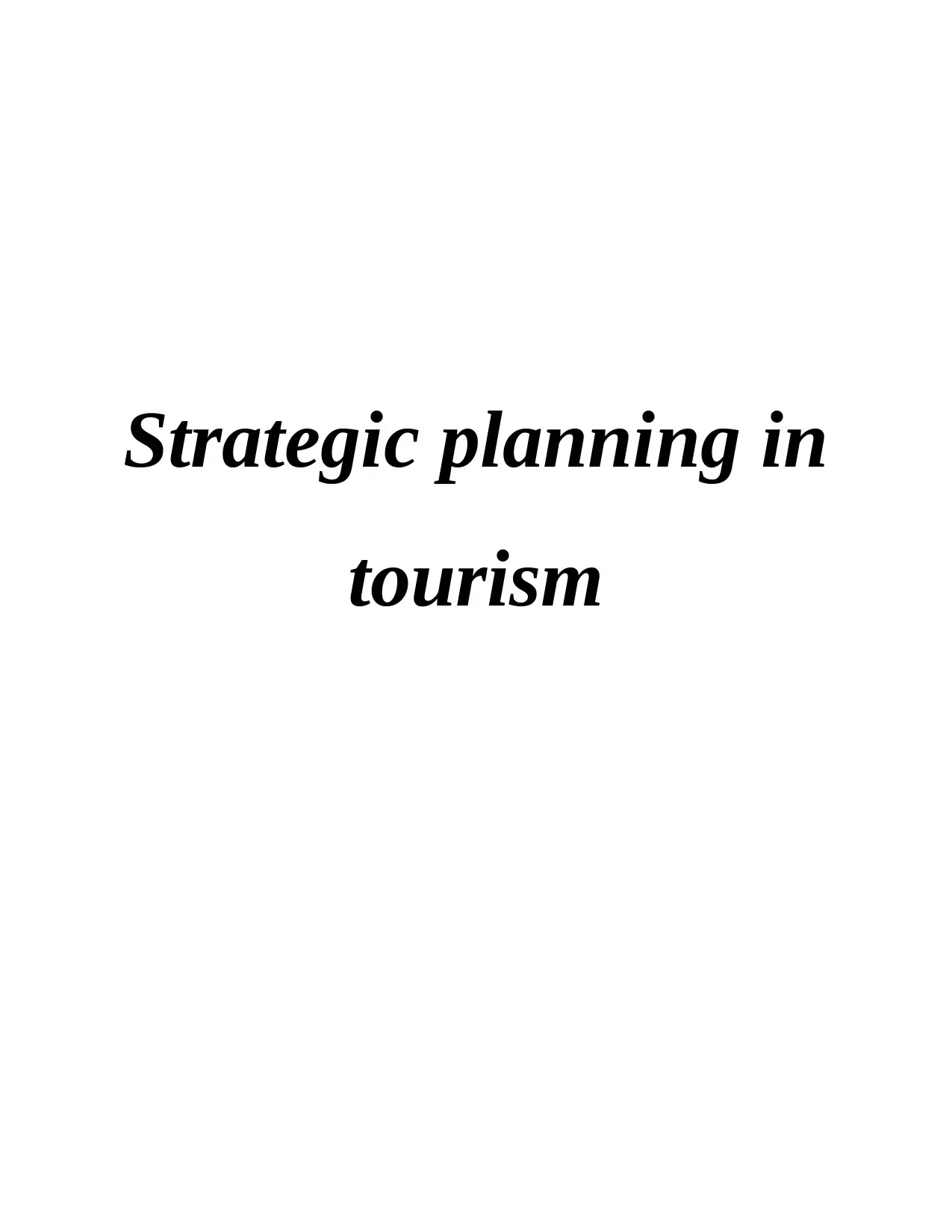
Strategic planning in
tourism
tourism
Paraphrase This Document
Need a fresh take? Get an instant paraphrase of this document with our AI Paraphraser
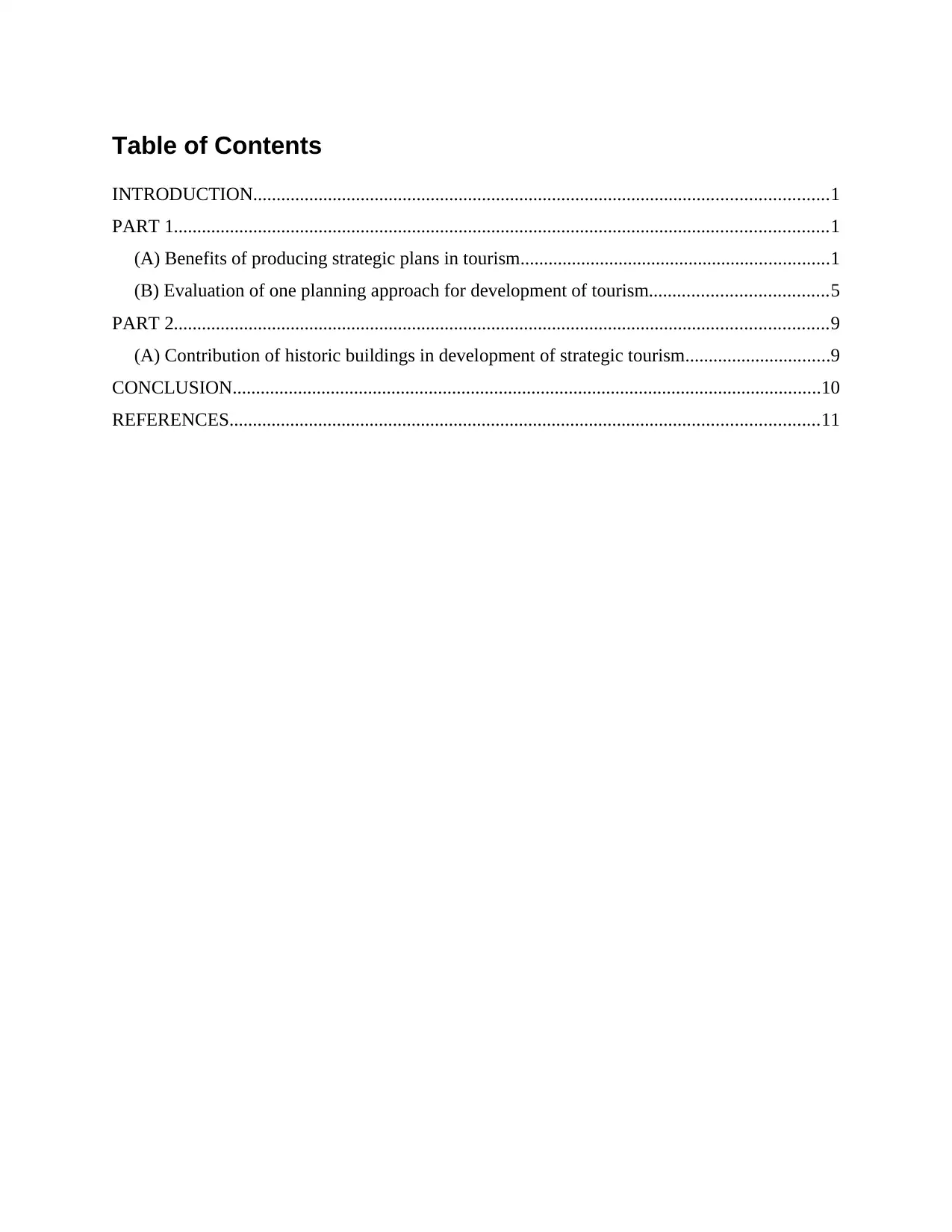
Table of Contents
INTRODUCTION...........................................................................................................................1
PART 1............................................................................................................................................1
(A) Benefits of producing strategic plans in tourism..................................................................1
(B) Evaluation of one planning approach for development of tourism......................................5
PART 2............................................................................................................................................9
(A) Contribution of historic buildings in development of strategic tourism...............................9
CONCLUSION..............................................................................................................................10
REFERENCES..............................................................................................................................11
INTRODUCTION...........................................................................................................................1
PART 1............................................................................................................................................1
(A) Benefits of producing strategic plans in tourism..................................................................1
(B) Evaluation of one planning approach for development of tourism......................................5
PART 2............................................................................................................................................9
(A) Contribution of historic buildings in development of strategic tourism...............................9
CONCLUSION..............................................................................................................................10
REFERENCES..............................................................................................................................11
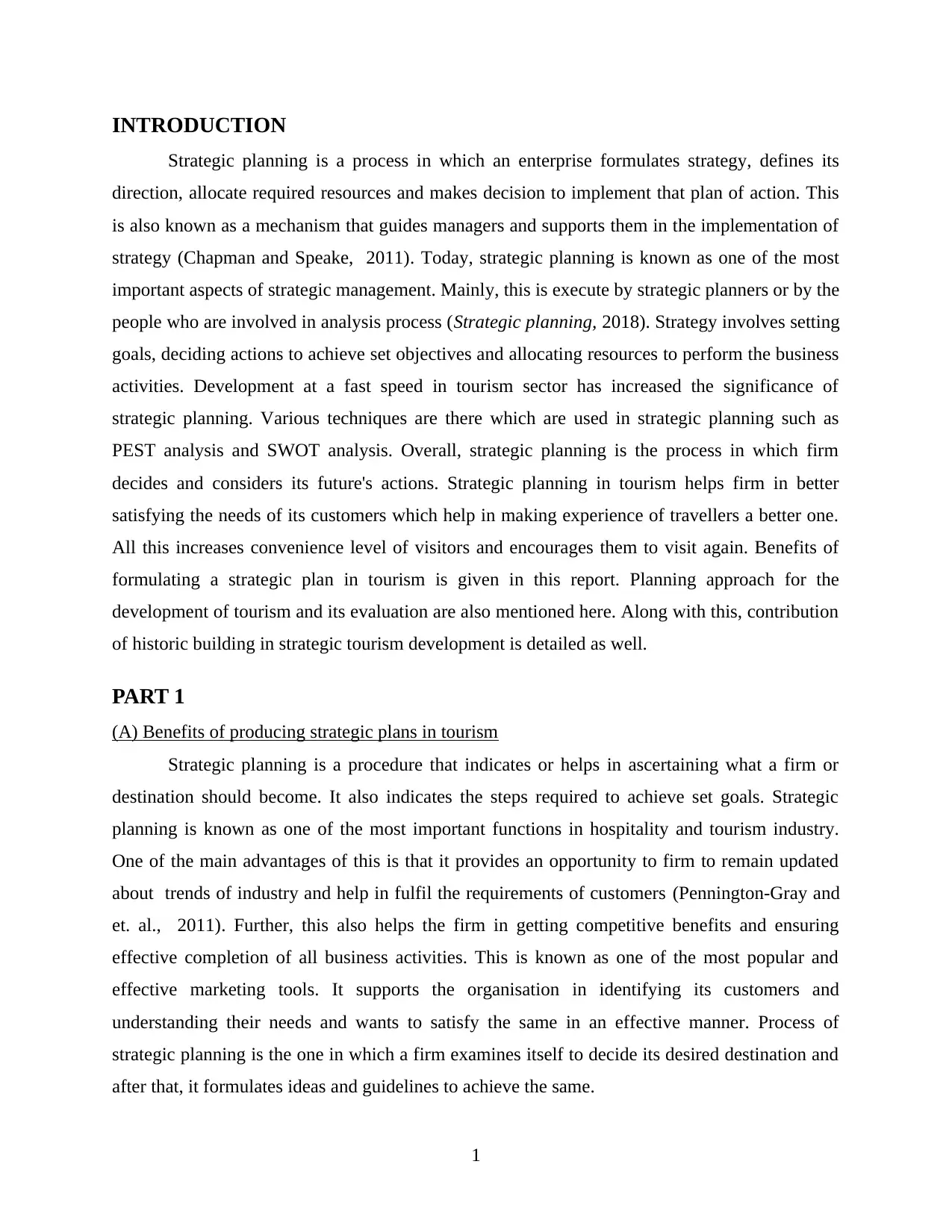
INTRODUCTION
Strategic planning is a process in which an enterprise formulates strategy, defines its
direction, allocate required resources and makes decision to implement that plan of action. This
is also known as a mechanism that guides managers and supports them in the implementation of
strategy (Chapman and Speake, 2011). Today, strategic planning is known as one of the most
important aspects of strategic management. Mainly, this is execute by strategic planners or by the
people who are involved in analysis process (Strategic planning, 2018). Strategy involves setting
goals, deciding actions to achieve set objectives and allocating resources to perform the business
activities. Development at a fast speed in tourism sector has increased the significance of
strategic planning. Various techniques are there which are used in strategic planning such as
PEST analysis and SWOT analysis. Overall, strategic planning is the process in which firm
decides and considers its future's actions. Strategic planning in tourism helps firm in better
satisfying the needs of its customers which help in making experience of travellers a better one.
All this increases convenience level of visitors and encourages them to visit again. Benefits of
formulating a strategic plan in tourism is given in this report. Planning approach for the
development of tourism and its evaluation are also mentioned here. Along with this, contribution
of historic building in strategic tourism development is detailed as well.
PART 1
(A) Benefits of producing strategic plans in tourism
Strategic planning is a procedure that indicates or helps in ascertaining what a firm or
destination should become. It also indicates the steps required to achieve set goals. Strategic
planning is known as one of the most important functions in hospitality and tourism industry.
One of the main advantages of this is that it provides an opportunity to firm to remain updated
about trends of industry and help in fulfil the requirements of customers (Pennington-Gray and
et. al., 2011). Further, this also helps the firm in getting competitive benefits and ensuring
effective completion of all business activities. This is known as one of the most popular and
effective marketing tools. It supports the organisation in identifying its customers and
understanding their needs and wants to satisfy the same in an effective manner. Process of
strategic planning is the one in which a firm examines itself to decide its desired destination and
after that, it formulates ideas and guidelines to achieve the same.
1
Strategic planning is a process in which an enterprise formulates strategy, defines its
direction, allocate required resources and makes decision to implement that plan of action. This
is also known as a mechanism that guides managers and supports them in the implementation of
strategy (Chapman and Speake, 2011). Today, strategic planning is known as one of the most
important aspects of strategic management. Mainly, this is execute by strategic planners or by the
people who are involved in analysis process (Strategic planning, 2018). Strategy involves setting
goals, deciding actions to achieve set objectives and allocating resources to perform the business
activities. Development at a fast speed in tourism sector has increased the significance of
strategic planning. Various techniques are there which are used in strategic planning such as
PEST analysis and SWOT analysis. Overall, strategic planning is the process in which firm
decides and considers its future's actions. Strategic planning in tourism helps firm in better
satisfying the needs of its customers which help in making experience of travellers a better one.
All this increases convenience level of visitors and encourages them to visit again. Benefits of
formulating a strategic plan in tourism is given in this report. Planning approach for the
development of tourism and its evaluation are also mentioned here. Along with this, contribution
of historic building in strategic tourism development is detailed as well.
PART 1
(A) Benefits of producing strategic plans in tourism
Strategic planning is a procedure that indicates or helps in ascertaining what a firm or
destination should become. It also indicates the steps required to achieve set goals. Strategic
planning is known as one of the most important functions in hospitality and tourism industry.
One of the main advantages of this is that it provides an opportunity to firm to remain updated
about trends of industry and help in fulfil the requirements of customers (Pennington-Gray and
et. al., 2011). Further, this also helps the firm in getting competitive benefits and ensuring
effective completion of all business activities. This is known as one of the most popular and
effective marketing tools. It supports the organisation in identifying its customers and
understanding their needs and wants to satisfy the same in an effective manner. Process of
strategic planning is the one in which a firm examines itself to decide its desired destination and
after that, it formulates ideas and guidelines to achieve the same.
1
⊘ This is a preview!⊘
Do you want full access?
Subscribe today to unlock all pages.

Trusted by 1+ million students worldwide
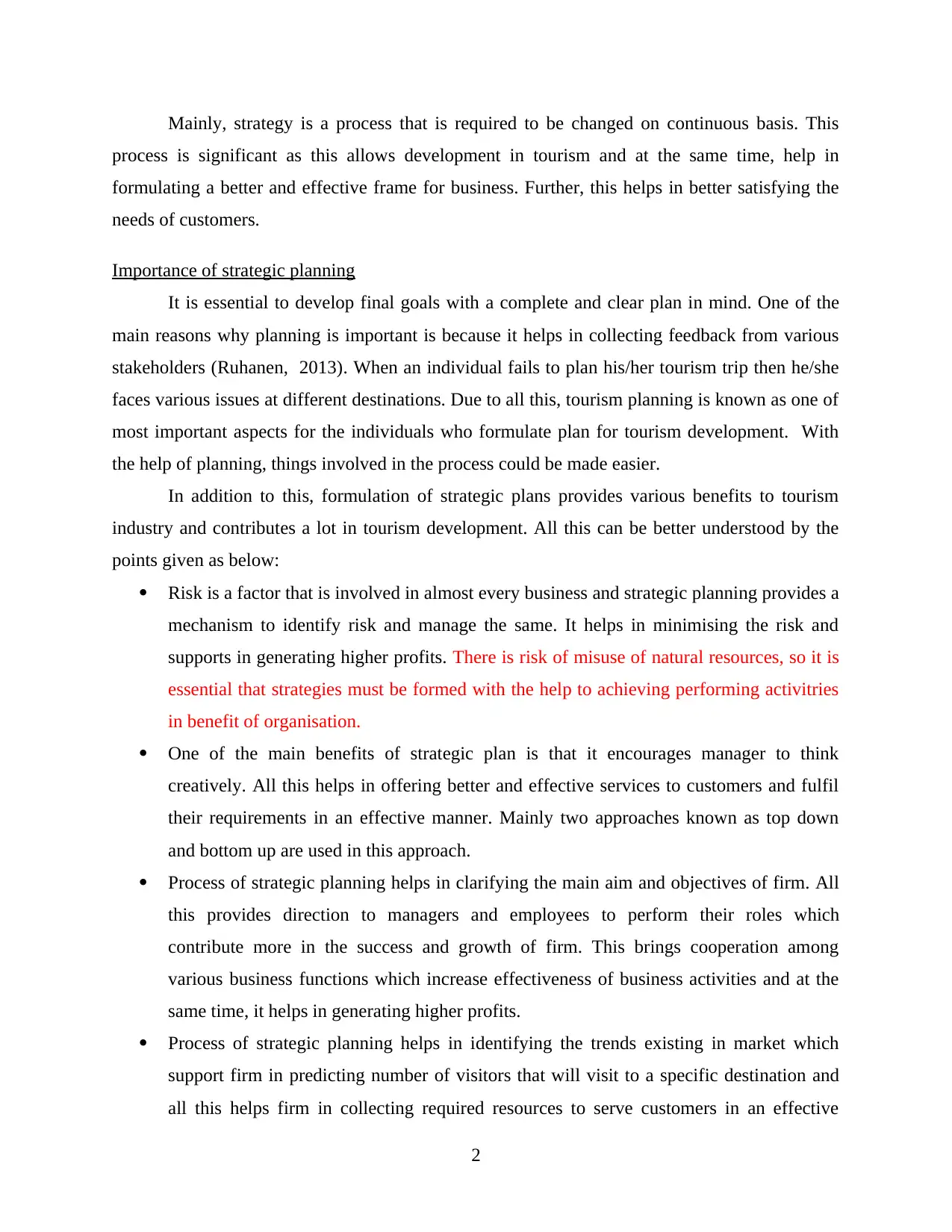
Mainly, strategy is a process that is required to be changed on continuous basis. This
process is significant as this allows development in tourism and at the same time, help in
formulating a better and effective frame for business. Further, this helps in better satisfying the
needs of customers.
Importance of strategic planning
It is essential to develop final goals with a complete and clear plan in mind. One of the
main reasons why planning is important is because it helps in collecting feedback from various
stakeholders (Ruhanen, 2013). When an individual fails to plan his/her tourism trip then he/she
faces various issues at different destinations. Due to all this, tourism planning is known as one of
most important aspects for the individuals who formulate plan for tourism development. With
the help of planning, things involved in the process could be made easier.
In addition to this, formulation of strategic plans provides various benefits to tourism
industry and contributes a lot in tourism development. All this can be better understood by the
points given as below:
Risk is a factor that is involved in almost every business and strategic planning provides a
mechanism to identify risk and manage the same. It helps in minimising the risk and
supports in generating higher profits. There is risk of misuse of natural resources, so it is
essential that strategies must be formed with the help to achieving performing activitries
in benefit of organisation.
One of the main benefits of strategic plan is that it encourages manager to think
creatively. All this helps in offering better and effective services to customers and fulfil
their requirements in an effective manner. Mainly two approaches known as top down
and bottom up are used in this approach.
Process of strategic planning helps in clarifying the main aim and objectives of firm. All
this provides direction to managers and employees to perform their roles which
contribute more in the success and growth of firm. This brings cooperation among
various business functions which increase effectiveness of business activities and at the
same time, it helps in generating higher profits.
Process of strategic planning helps in identifying the trends existing in market which
support firm in predicting number of visitors that will visit to a specific destination and
all this helps firm in collecting required resources to serve customers in an effective
2
process is significant as this allows development in tourism and at the same time, help in
formulating a better and effective frame for business. Further, this helps in better satisfying the
needs of customers.
Importance of strategic planning
It is essential to develop final goals with a complete and clear plan in mind. One of the
main reasons why planning is important is because it helps in collecting feedback from various
stakeholders (Ruhanen, 2013). When an individual fails to plan his/her tourism trip then he/she
faces various issues at different destinations. Due to all this, tourism planning is known as one of
most important aspects for the individuals who formulate plan for tourism development. With
the help of planning, things involved in the process could be made easier.
In addition to this, formulation of strategic plans provides various benefits to tourism
industry and contributes a lot in tourism development. All this can be better understood by the
points given as below:
Risk is a factor that is involved in almost every business and strategic planning provides a
mechanism to identify risk and manage the same. It helps in minimising the risk and
supports in generating higher profits. There is risk of misuse of natural resources, so it is
essential that strategies must be formed with the help to achieving performing activitries
in benefit of organisation.
One of the main benefits of strategic plan is that it encourages manager to think
creatively. All this helps in offering better and effective services to customers and fulfil
their requirements in an effective manner. Mainly two approaches known as top down
and bottom up are used in this approach.
Process of strategic planning helps in clarifying the main aim and objectives of firm. All
this provides direction to managers and employees to perform their roles which
contribute more in the success and growth of firm. This brings cooperation among
various business functions which increase effectiveness of business activities and at the
same time, it helps in generating higher profits.
Process of strategic planning helps in identifying the trends existing in market which
support firm in predicting number of visitors that will visit to a specific destination and
all this helps firm in collecting required resources to serve customers in an effective
2
Paraphrase This Document
Need a fresh take? Get an instant paraphrase of this document with our AI Paraphraser
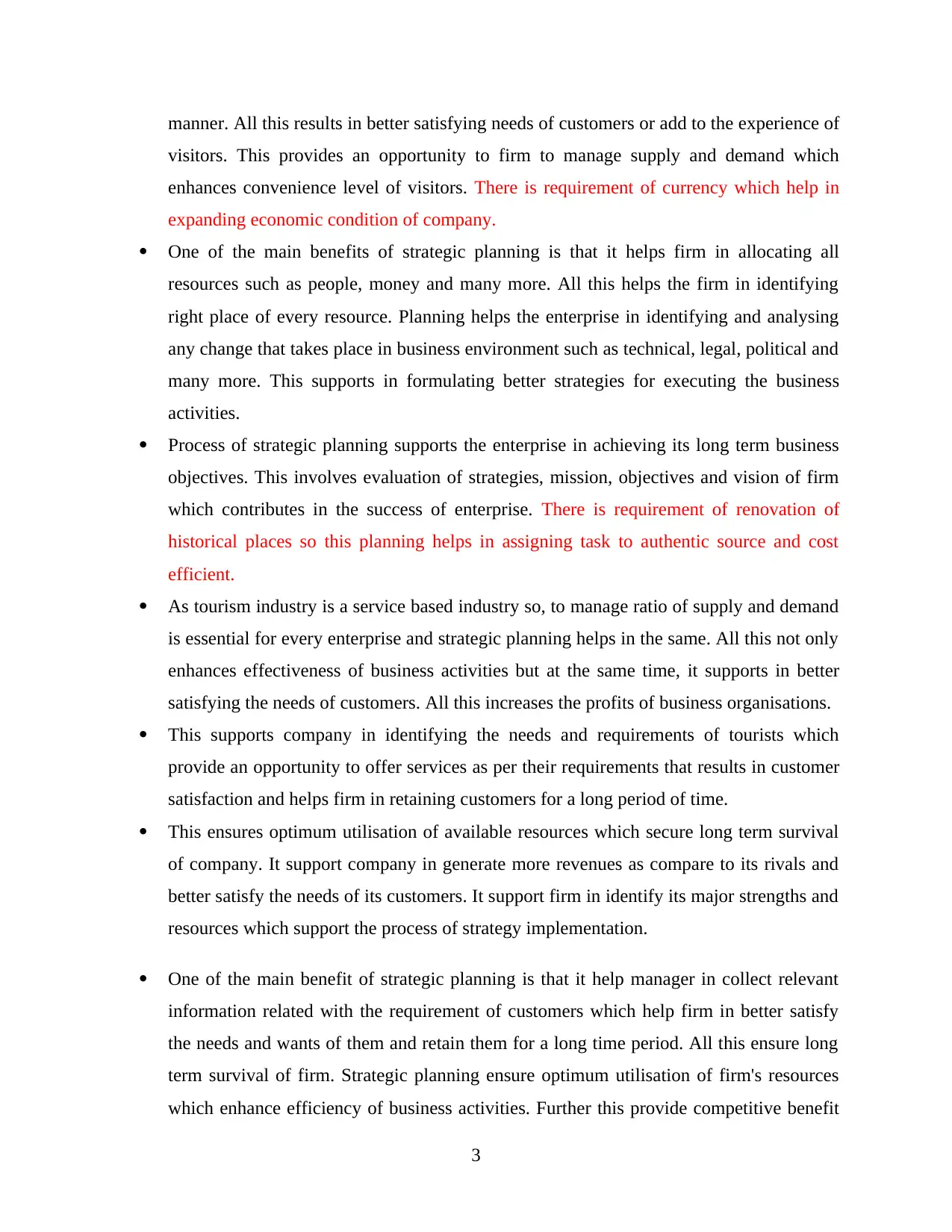
manner. All this results in better satisfying needs of customers or add to the experience of
visitors. This provides an opportunity to firm to manage supply and demand which
enhances convenience level of visitors. There is requirement of currency which help in
expanding economic condition of company.
One of the main benefits of strategic planning is that it helps firm in allocating all
resources such as people, money and many more. All this helps the firm in identifying
right place of every resource. Planning helps the enterprise in identifying and analysing
any change that takes place in business environment such as technical, legal, political and
many more. This supports in formulating better strategies for executing the business
activities.
Process of strategic planning supports the enterprise in achieving its long term business
objectives. This involves evaluation of strategies, mission, objectives and vision of firm
which contributes in the success of enterprise. There is requirement of renovation of
historical places so this planning helps in assigning task to authentic source and cost
efficient.
As tourism industry is a service based industry so, to manage ratio of supply and demand
is essential for every enterprise and strategic planning helps in the same. All this not only
enhances effectiveness of business activities but at the same time, it supports in better
satisfying the needs of customers. All this increases the profits of business organisations.
This supports company in identifying the needs and requirements of tourists which
provide an opportunity to offer services as per their requirements that results in customer
satisfaction and helps firm in retaining customers for a long period of time.
This ensures optimum utilisation of available resources which secure long term survival
of company. It support company in generate more revenues as compare to its rivals and
better satisfy the needs of its customers. It support firm in identify its major strengths and
resources which support the process of strategy implementation.
One of the main benefit of strategic planning is that it help manager in collect relevant
information related with the requirement of customers which help firm in better satisfy
the needs and wants of them and retain them for a long time period. All this ensure long
term survival of firm. Strategic planning ensure optimum utilisation of firm's resources
which enhance efficiency of business activities. Further this provide competitive benefit
3
visitors. This provides an opportunity to firm to manage supply and demand which
enhances convenience level of visitors. There is requirement of currency which help in
expanding economic condition of company.
One of the main benefits of strategic planning is that it helps firm in allocating all
resources such as people, money and many more. All this helps the firm in identifying
right place of every resource. Planning helps the enterprise in identifying and analysing
any change that takes place in business environment such as technical, legal, political and
many more. This supports in formulating better strategies for executing the business
activities.
Process of strategic planning supports the enterprise in achieving its long term business
objectives. This involves evaluation of strategies, mission, objectives and vision of firm
which contributes in the success of enterprise. There is requirement of renovation of
historical places so this planning helps in assigning task to authentic source and cost
efficient.
As tourism industry is a service based industry so, to manage ratio of supply and demand
is essential for every enterprise and strategic planning helps in the same. All this not only
enhances effectiveness of business activities but at the same time, it supports in better
satisfying the needs of customers. All this increases the profits of business organisations.
This supports company in identifying the needs and requirements of tourists which
provide an opportunity to offer services as per their requirements that results in customer
satisfaction and helps firm in retaining customers for a long period of time.
This ensures optimum utilisation of available resources which secure long term survival
of company. It support company in generate more revenues as compare to its rivals and
better satisfy the needs of its customers. It support firm in identify its major strengths and
resources which support the process of strategy implementation.
One of the main benefit of strategic planning is that it help manager in collect relevant
information related with the requirement of customers which help firm in better satisfy
the needs and wants of them and retain them for a long time period. All this ensure long
term survival of firm. Strategic planning ensure optimum utilisation of firm's resources
which enhance efficiency of business activities. Further this provide competitive benefit
3
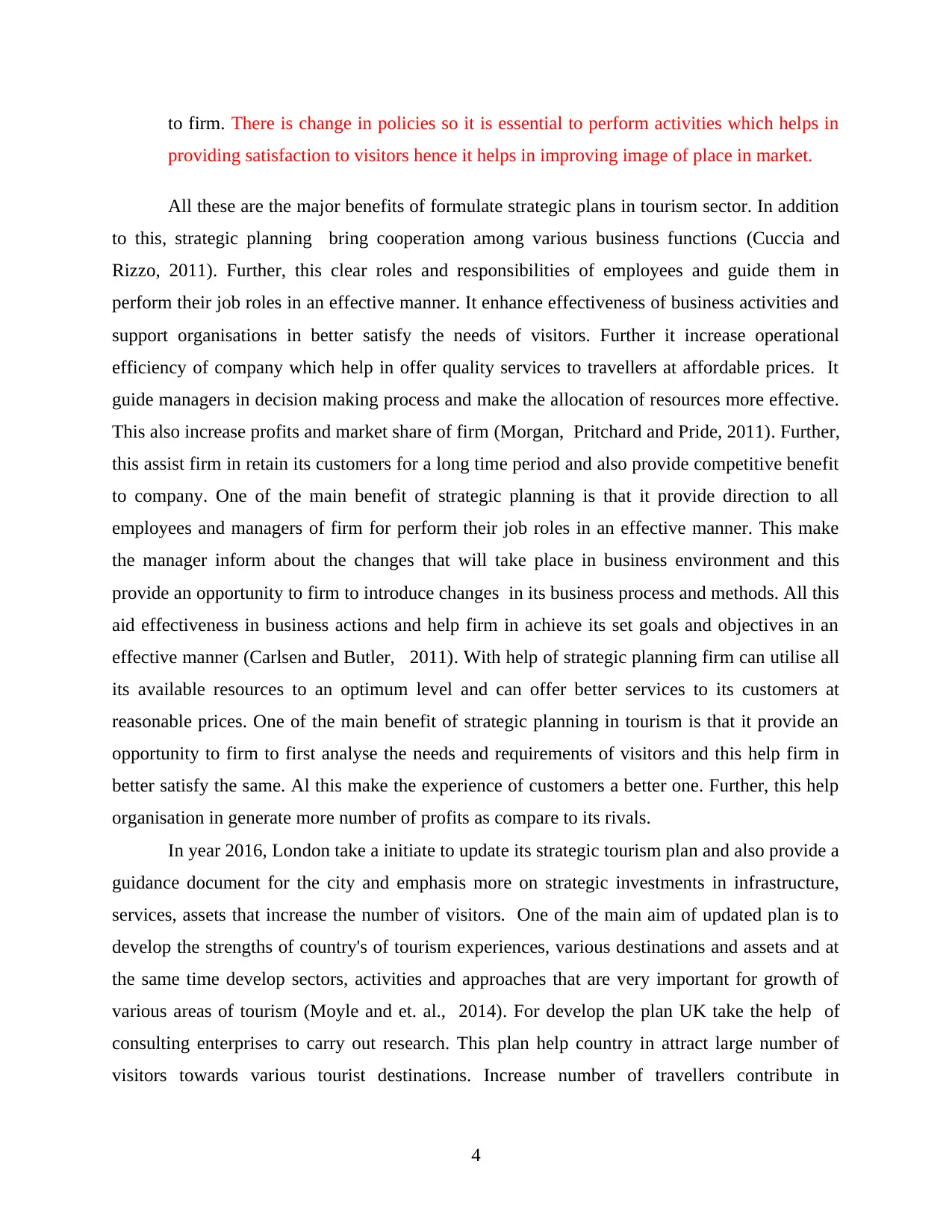
to firm. There is change in policies so it is essential to perform activities which helps in
providing satisfaction to visitors hence it helps in improving image of place in market.
All these are the major benefits of formulate strategic plans in tourism sector. In addition
to this, strategic planning bring cooperation among various business functions (Cuccia and
Rizzo, 2011). Further, this clear roles and responsibilities of employees and guide them in
perform their job roles in an effective manner. It enhance effectiveness of business activities and
support organisations in better satisfy the needs of visitors. Further it increase operational
efficiency of company which help in offer quality services to travellers at affordable prices. It
guide managers in decision making process and make the allocation of resources more effective.
This also increase profits and market share of firm (Morgan, Pritchard and Pride, 2011). Further,
this assist firm in retain its customers for a long time period and also provide competitive benefit
to company. One of the main benefit of strategic planning is that it provide direction to all
employees and managers of firm for perform their job roles in an effective manner. This make
the manager inform about the changes that will take place in business environment and this
provide an opportunity to firm to introduce changes in its business process and methods. All this
aid effectiveness in business actions and help firm in achieve its set goals and objectives in an
effective manner (Carlsen and Butler, 2011). With help of strategic planning firm can utilise all
its available resources to an optimum level and can offer better services to its customers at
reasonable prices. One of the main benefit of strategic planning in tourism is that it provide an
opportunity to firm to first analyse the needs and requirements of visitors and this help firm in
better satisfy the same. Al this make the experience of customers a better one. Further, this help
organisation in generate more number of profits as compare to its rivals.
In year 2016, London take a initiate to update its strategic tourism plan and also provide a
guidance document for the city and emphasis more on strategic investments in infrastructure,
services, assets that increase the number of visitors. One of the main aim of updated plan is to
develop the strengths of country's of tourism experiences, various destinations and assets and at
the same time develop sectors, activities and approaches that are very important for growth of
various areas of tourism (Moyle and et. al., 2014). For develop the plan UK take the help of
consulting enterprises to carry out research. This plan help country in attract large number of
visitors towards various tourist destinations. Increase number of travellers contribute in
4
providing satisfaction to visitors hence it helps in improving image of place in market.
All these are the major benefits of formulate strategic plans in tourism sector. In addition
to this, strategic planning bring cooperation among various business functions (Cuccia and
Rizzo, 2011). Further, this clear roles and responsibilities of employees and guide them in
perform their job roles in an effective manner. It enhance effectiveness of business activities and
support organisations in better satisfy the needs of visitors. Further it increase operational
efficiency of company which help in offer quality services to travellers at affordable prices. It
guide managers in decision making process and make the allocation of resources more effective.
This also increase profits and market share of firm (Morgan, Pritchard and Pride, 2011). Further,
this assist firm in retain its customers for a long time period and also provide competitive benefit
to company. One of the main benefit of strategic planning is that it provide direction to all
employees and managers of firm for perform their job roles in an effective manner. This make
the manager inform about the changes that will take place in business environment and this
provide an opportunity to firm to introduce changes in its business process and methods. All this
aid effectiveness in business actions and help firm in achieve its set goals and objectives in an
effective manner (Carlsen and Butler, 2011). With help of strategic planning firm can utilise all
its available resources to an optimum level and can offer better services to its customers at
reasonable prices. One of the main benefit of strategic planning in tourism is that it provide an
opportunity to firm to first analyse the needs and requirements of visitors and this help firm in
better satisfy the same. Al this make the experience of customers a better one. Further, this help
organisation in generate more number of profits as compare to its rivals.
In year 2016, London take a initiate to update its strategic tourism plan and also provide a
guidance document for the city and emphasis more on strategic investments in infrastructure,
services, assets that increase the number of visitors. One of the main aim of updated plan is to
develop the strengths of country's of tourism experiences, various destinations and assets and at
the same time develop sectors, activities and approaches that are very important for growth of
various areas of tourism (Moyle and et. al., 2014). For develop the plan UK take the help of
consulting enterprises to carry out research. This plan help country in attract large number of
visitors towards various tourist destinations. Increase number of travellers contribute in
4
⊘ This is a preview!⊘
Do you want full access?
Subscribe today to unlock all pages.

Trusted by 1+ million students worldwide
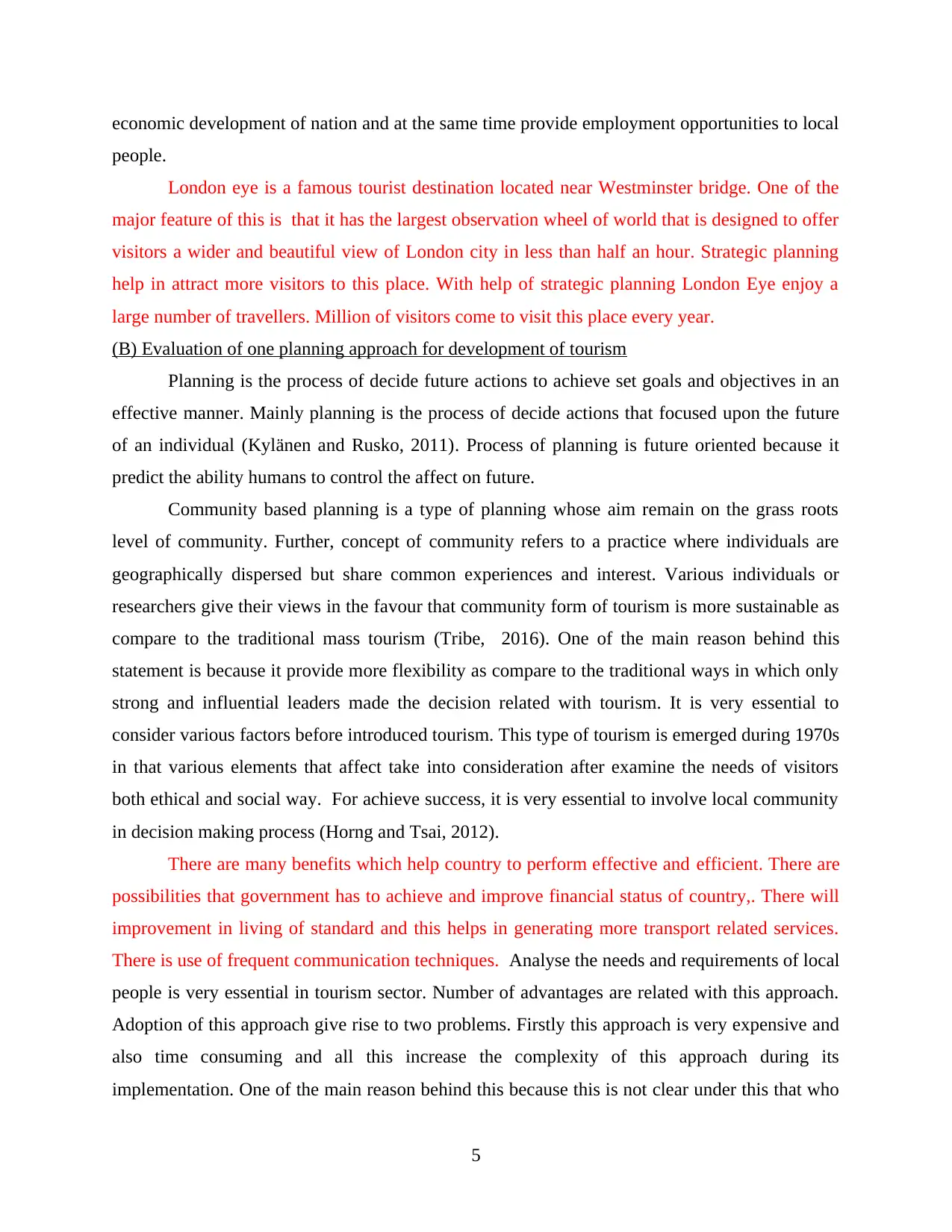
economic development of nation and at the same time provide employment opportunities to local
people.
London eye is a famous tourist destination located near Westminster bridge. One of the
major feature of this is that it has the largest observation wheel of world that is designed to offer
visitors a wider and beautiful view of London city in less than half an hour. Strategic planning
help in attract more visitors to this place. With help of strategic planning London Eye enjoy a
large number of travellers. Million of visitors come to visit this place every year.
(B) Evaluation of one planning approach for development of tourism
Planning is the process of decide future actions to achieve set goals and objectives in an
effective manner. Mainly planning is the process of decide actions that focused upon the future
of an individual (Kylänen and Rusko, 2011). Process of planning is future oriented because it
predict the ability humans to control the affect on future.
Community based planning is a type of planning whose aim remain on the grass roots
level of community. Further, concept of community refers to a practice where individuals are
geographically dispersed but share common experiences and interest. Various individuals or
researchers give their views in the favour that community form of tourism is more sustainable as
compare to the traditional mass tourism (Tribe, 2016). One of the main reason behind this
statement is because it provide more flexibility as compare to the traditional ways in which only
strong and influential leaders made the decision related with tourism. It is very essential to
consider various factors before introduced tourism. This type of tourism is emerged during 1970s
in that various elements that affect take into consideration after examine the needs of visitors
both ethical and social way. For achieve success, it is very essential to involve local community
in decision making process (Horng and Tsai, 2012).
There are many benefits which help country to perform effective and efficient. There are
possibilities that government has to achieve and improve financial status of country,. There will
improvement in living of standard and this helps in generating more transport related services.
There is use of frequent communication techniques. Analyse the needs and requirements of local
people is very essential in tourism sector. Number of advantages are related with this approach.
Adoption of this approach give rise to two problems. Firstly this approach is very expensive and
also time consuming and all this increase the complexity of this approach during its
implementation. One of the main reason behind this because this is not clear under this that who
5
people.
London eye is a famous tourist destination located near Westminster bridge. One of the
major feature of this is that it has the largest observation wheel of world that is designed to offer
visitors a wider and beautiful view of London city in less than half an hour. Strategic planning
help in attract more visitors to this place. With help of strategic planning London Eye enjoy a
large number of travellers. Million of visitors come to visit this place every year.
(B) Evaluation of one planning approach for development of tourism
Planning is the process of decide future actions to achieve set goals and objectives in an
effective manner. Mainly planning is the process of decide actions that focused upon the future
of an individual (Kylänen and Rusko, 2011). Process of planning is future oriented because it
predict the ability humans to control the affect on future.
Community based planning is a type of planning whose aim remain on the grass roots
level of community. Further, concept of community refers to a practice where individuals are
geographically dispersed but share common experiences and interest. Various individuals or
researchers give their views in the favour that community form of tourism is more sustainable as
compare to the traditional mass tourism (Tribe, 2016). One of the main reason behind this
statement is because it provide more flexibility as compare to the traditional ways in which only
strong and influential leaders made the decision related with tourism. It is very essential to
consider various factors before introduced tourism. This type of tourism is emerged during 1970s
in that various elements that affect take into consideration after examine the needs of visitors
both ethical and social way. For achieve success, it is very essential to involve local community
in decision making process (Horng and Tsai, 2012).
There are many benefits which help country to perform effective and efficient. There are
possibilities that government has to achieve and improve financial status of country,. There will
improvement in living of standard and this helps in generating more transport related services.
There is use of frequent communication techniques. Analyse the needs and requirements of local
people is very essential in tourism sector. Number of advantages are related with this approach.
Adoption of this approach give rise to two problems. Firstly this approach is very expensive and
also time consuming and all this increase the complexity of this approach during its
implementation. One of the main reason behind this because this is not clear under this that who
5
Paraphrase This Document
Need a fresh take? Get an instant paraphrase of this document with our AI Paraphraser
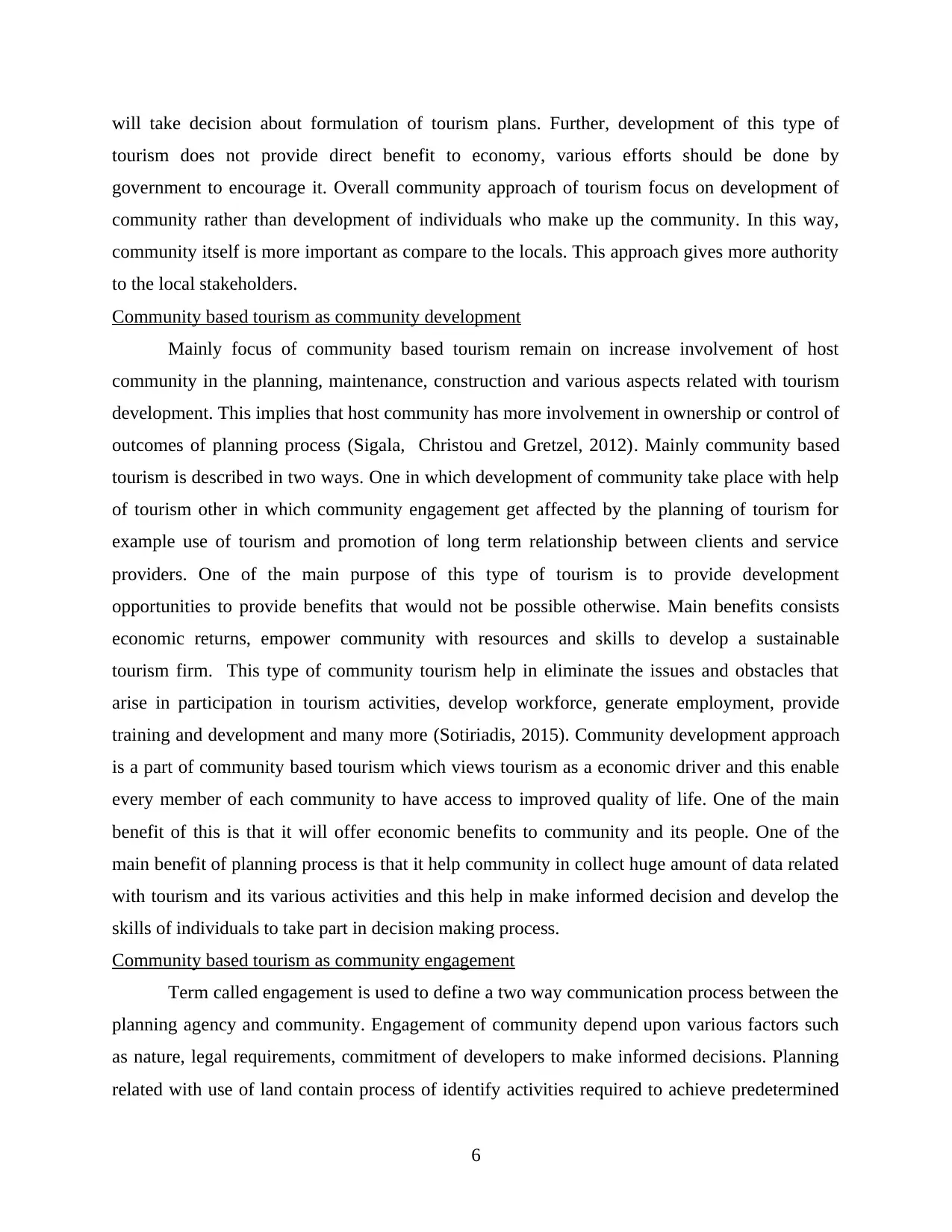
will take decision about formulation of tourism plans. Further, development of this type of
tourism does not provide direct benefit to economy, various efforts should be done by
government to encourage it. Overall community approach of tourism focus on development of
community rather than development of individuals who make up the community. In this way,
community itself is more important as compare to the locals. This approach gives more authority
to the local stakeholders.
Community based tourism as community development
Mainly focus of community based tourism remain on increase involvement of host
community in the planning, maintenance, construction and various aspects related with tourism
development. This implies that host community has more involvement in ownership or control of
outcomes of planning process (Sigala, Christou and Gretzel, 2012). Mainly community based
tourism is described in two ways. One in which development of community take place with help
of tourism other in which community engagement get affected by the planning of tourism for
example use of tourism and promotion of long term relationship between clients and service
providers. One of the main purpose of this type of tourism is to provide development
opportunities to provide benefits that would not be possible otherwise. Main benefits consists
economic returns, empower community with resources and skills to develop a sustainable
tourism firm. This type of community tourism help in eliminate the issues and obstacles that
arise in participation in tourism activities, develop workforce, generate employment, provide
training and development and many more (Sotiriadis, 2015). Community development approach
is a part of community based tourism which views tourism as a economic driver and this enable
every member of each community to have access to improved quality of life. One of the main
benefit of this is that it will offer economic benefits to community and its people. One of the
main benefit of planning process is that it help community in collect huge amount of data related
with tourism and its various activities and this help in make informed decision and develop the
skills of individuals to take part in decision making process.
Community based tourism as community engagement
Term called engagement is used to define a two way communication process between the
planning agency and community. Engagement of community depend upon various factors such
as nature, legal requirements, commitment of developers to make informed decisions. Planning
related with use of land contain process of identify activities required to achieve predetermined
6
tourism does not provide direct benefit to economy, various efforts should be done by
government to encourage it. Overall community approach of tourism focus on development of
community rather than development of individuals who make up the community. In this way,
community itself is more important as compare to the locals. This approach gives more authority
to the local stakeholders.
Community based tourism as community development
Mainly focus of community based tourism remain on increase involvement of host
community in the planning, maintenance, construction and various aspects related with tourism
development. This implies that host community has more involvement in ownership or control of
outcomes of planning process (Sigala, Christou and Gretzel, 2012). Mainly community based
tourism is described in two ways. One in which development of community take place with help
of tourism other in which community engagement get affected by the planning of tourism for
example use of tourism and promotion of long term relationship between clients and service
providers. One of the main purpose of this type of tourism is to provide development
opportunities to provide benefits that would not be possible otherwise. Main benefits consists
economic returns, empower community with resources and skills to develop a sustainable
tourism firm. This type of community tourism help in eliminate the issues and obstacles that
arise in participation in tourism activities, develop workforce, generate employment, provide
training and development and many more (Sotiriadis, 2015). Community development approach
is a part of community based tourism which views tourism as a economic driver and this enable
every member of each community to have access to improved quality of life. One of the main
benefit of this is that it will offer economic benefits to community and its people. One of the
main benefit of planning process is that it help community in collect huge amount of data related
with tourism and its various activities and this help in make informed decision and develop the
skills of individuals to take part in decision making process.
Community based tourism as community engagement
Term called engagement is used to define a two way communication process between the
planning agency and community. Engagement of community depend upon various factors such
as nature, legal requirements, commitment of developers to make informed decisions. Planning
related with use of land contain process of identify activities required to achieve predetermined
6
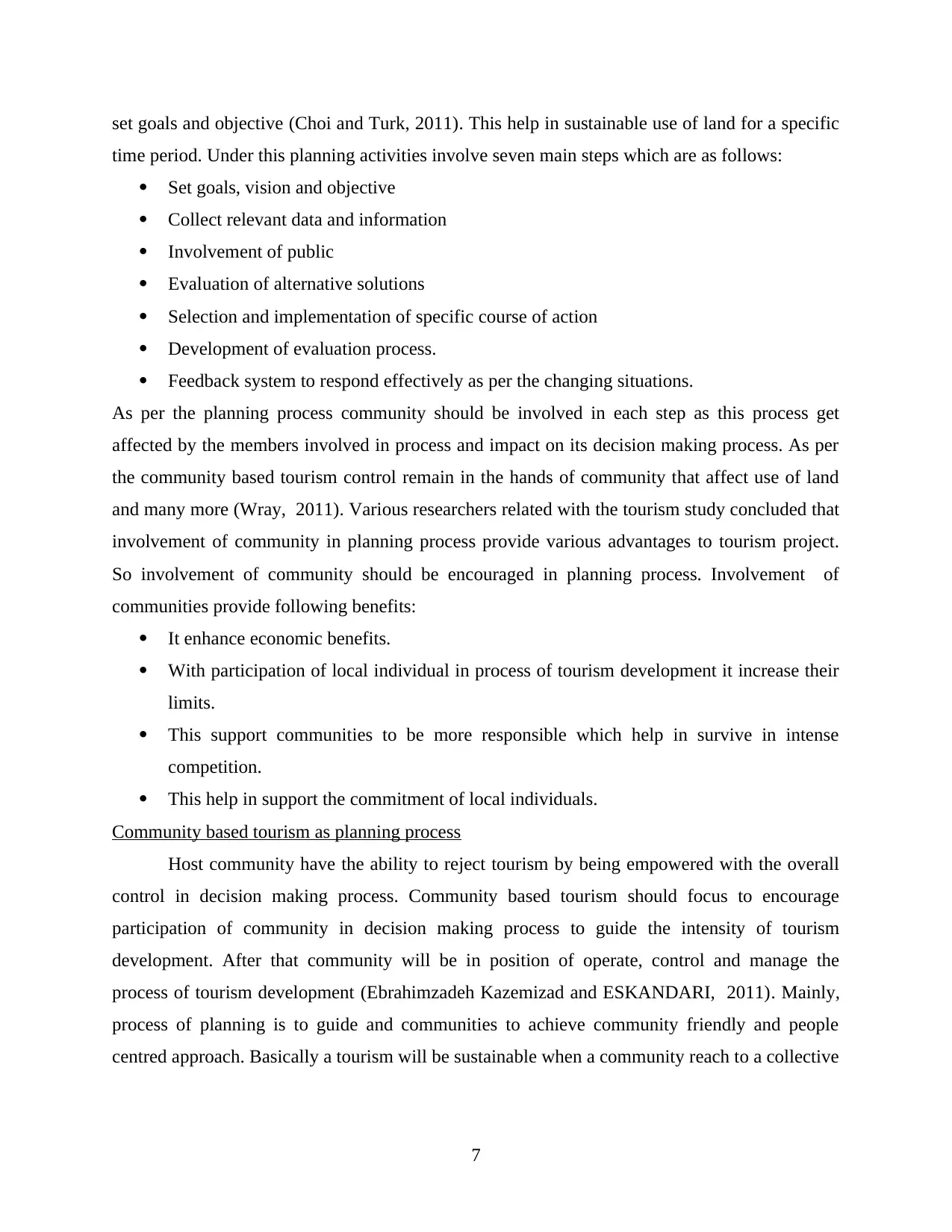
set goals and objective (Choi and Turk, 2011). This help in sustainable use of land for a specific
time period. Under this planning activities involve seven main steps which are as follows:
Set goals, vision and objective
Collect relevant data and information
Involvement of public
Evaluation of alternative solutions
Selection and implementation of specific course of action
Development of evaluation process.
Feedback system to respond effectively as per the changing situations.
As per the planning process community should be involved in each step as this process get
affected by the members involved in process and impact on its decision making process. As per
the community based tourism control remain in the hands of community that affect use of land
and many more (Wray, 2011). Various researchers related with the tourism study concluded that
involvement of community in planning process provide various advantages to tourism project.
So involvement of community should be encouraged in planning process. Involvement of
communities provide following benefits:
It enhance economic benefits.
With participation of local individual in process of tourism development it increase their
limits.
This support communities to be more responsible which help in survive in intense
competition.
This help in support the commitment of local individuals.
Community based tourism as planning process
Host community have the ability to reject tourism by being empowered with the overall
control in decision making process. Community based tourism should focus to encourage
participation of community in decision making process to guide the intensity of tourism
development. After that community will be in position of operate, control and manage the
process of tourism development (Ebrahimzadeh Kazemizad and ESKANDARI, 2011). Mainly,
process of planning is to guide and communities to achieve community friendly and people
centred approach. Basically a tourism will be sustainable when a community reach to a collective
7
time period. Under this planning activities involve seven main steps which are as follows:
Set goals, vision and objective
Collect relevant data and information
Involvement of public
Evaluation of alternative solutions
Selection and implementation of specific course of action
Development of evaluation process.
Feedback system to respond effectively as per the changing situations.
As per the planning process community should be involved in each step as this process get
affected by the members involved in process and impact on its decision making process. As per
the community based tourism control remain in the hands of community that affect use of land
and many more (Wray, 2011). Various researchers related with the tourism study concluded that
involvement of community in planning process provide various advantages to tourism project.
So involvement of community should be encouraged in planning process. Involvement of
communities provide following benefits:
It enhance economic benefits.
With participation of local individual in process of tourism development it increase their
limits.
This support communities to be more responsible which help in survive in intense
competition.
This help in support the commitment of local individuals.
Community based tourism as planning process
Host community have the ability to reject tourism by being empowered with the overall
control in decision making process. Community based tourism should focus to encourage
participation of community in decision making process to guide the intensity of tourism
development. After that community will be in position of operate, control and manage the
process of tourism development (Ebrahimzadeh Kazemizad and ESKANDARI, 2011). Mainly,
process of planning is to guide and communities to achieve community friendly and people
centred approach. Basically a tourism will be sustainable when a community reach to a collective
7
⊘ This is a preview!⊘
Do you want full access?
Subscribe today to unlock all pages.

Trusted by 1+ million students worldwide
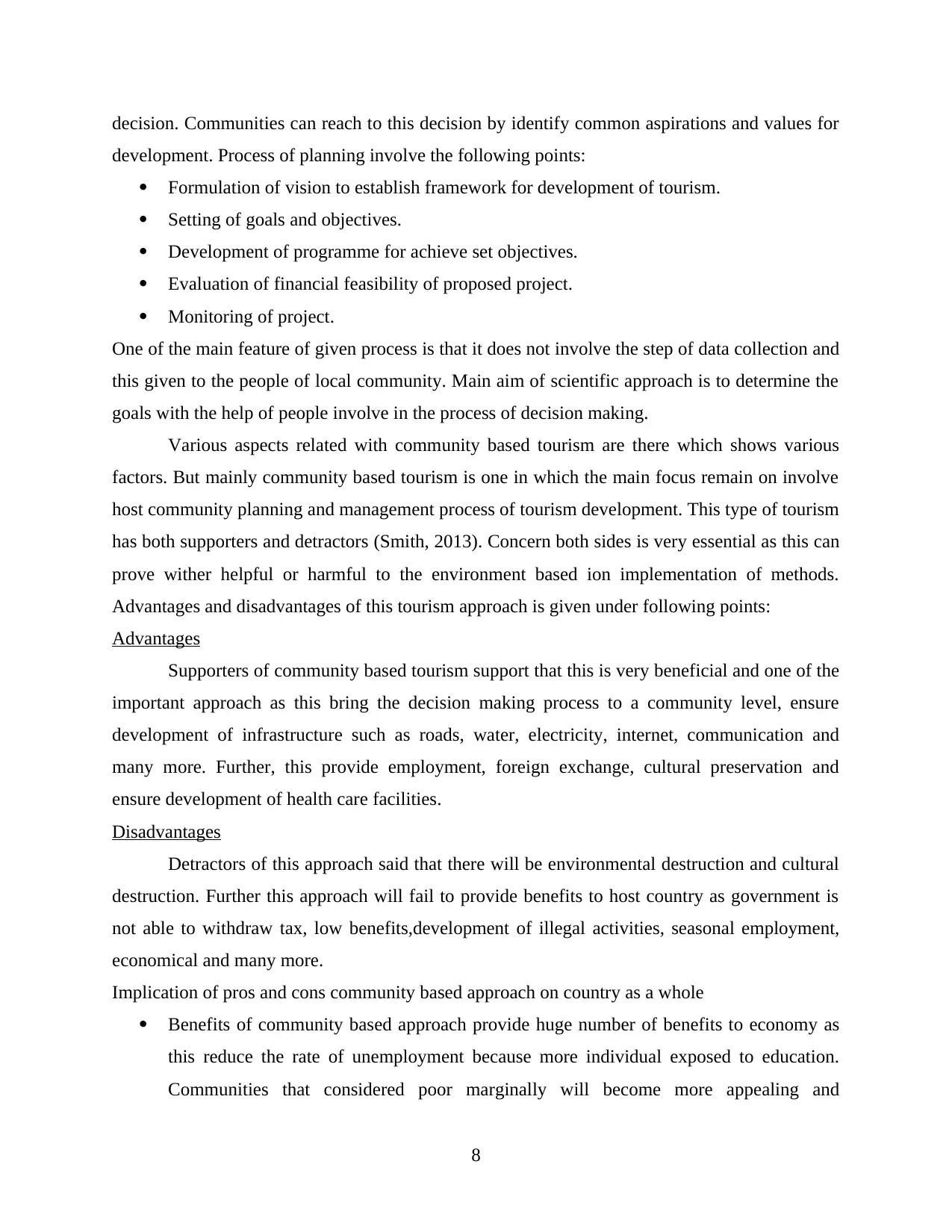
decision. Communities can reach to this decision by identify common aspirations and values for
development. Process of planning involve the following points:
Formulation of vision to establish framework for development of tourism.
Setting of goals and objectives.
Development of programme for achieve set objectives.
Evaluation of financial feasibility of proposed project.
Monitoring of project.
One of the main feature of given process is that it does not involve the step of data collection and
this given to the people of local community. Main aim of scientific approach is to determine the
goals with the help of people involve in the process of decision making.
Various aspects related with community based tourism are there which shows various
factors. But mainly community based tourism is one in which the main focus remain on involve
host community planning and management process of tourism development. This type of tourism
has both supporters and detractors (Smith, 2013). Concern both sides is very essential as this can
prove wither helpful or harmful to the environment based ion implementation of methods.
Advantages and disadvantages of this tourism approach is given under following points:
Advantages
Supporters of community based tourism support that this is very beneficial and one of the
important approach as this bring the decision making process to a community level, ensure
development of infrastructure such as roads, water, electricity, internet, communication and
many more. Further, this provide employment, foreign exchange, cultural preservation and
ensure development of health care facilities.
Disadvantages
Detractors of this approach said that there will be environmental destruction and cultural
destruction. Further this approach will fail to provide benefits to host country as government is
not able to withdraw tax, low benefits,development of illegal activities, seasonal employment,
economical and many more.
Implication of pros and cons community based approach on country as a whole
Benefits of community based approach provide huge number of benefits to economy as
this reduce the rate of unemployment because more individual exposed to education.
Communities that considered poor marginally will become more appealing and
8
development. Process of planning involve the following points:
Formulation of vision to establish framework for development of tourism.
Setting of goals and objectives.
Development of programme for achieve set objectives.
Evaluation of financial feasibility of proposed project.
Monitoring of project.
One of the main feature of given process is that it does not involve the step of data collection and
this given to the people of local community. Main aim of scientific approach is to determine the
goals with the help of people involve in the process of decision making.
Various aspects related with community based tourism are there which shows various
factors. But mainly community based tourism is one in which the main focus remain on involve
host community planning and management process of tourism development. This type of tourism
has both supporters and detractors (Smith, 2013). Concern both sides is very essential as this can
prove wither helpful or harmful to the environment based ion implementation of methods.
Advantages and disadvantages of this tourism approach is given under following points:
Advantages
Supporters of community based tourism support that this is very beneficial and one of the
important approach as this bring the decision making process to a community level, ensure
development of infrastructure such as roads, water, electricity, internet, communication and
many more. Further, this provide employment, foreign exchange, cultural preservation and
ensure development of health care facilities.
Disadvantages
Detractors of this approach said that there will be environmental destruction and cultural
destruction. Further this approach will fail to provide benefits to host country as government is
not able to withdraw tax, low benefits,development of illegal activities, seasonal employment,
economical and many more.
Implication of pros and cons community based approach on country as a whole
Benefits of community based approach provide huge number of benefits to economy as
this reduce the rate of unemployment because more individual exposed to education.
Communities that considered poor marginally will become more appealing and
8
Paraphrase This Document
Need a fresh take? Get an instant paraphrase of this document with our AI Paraphraser
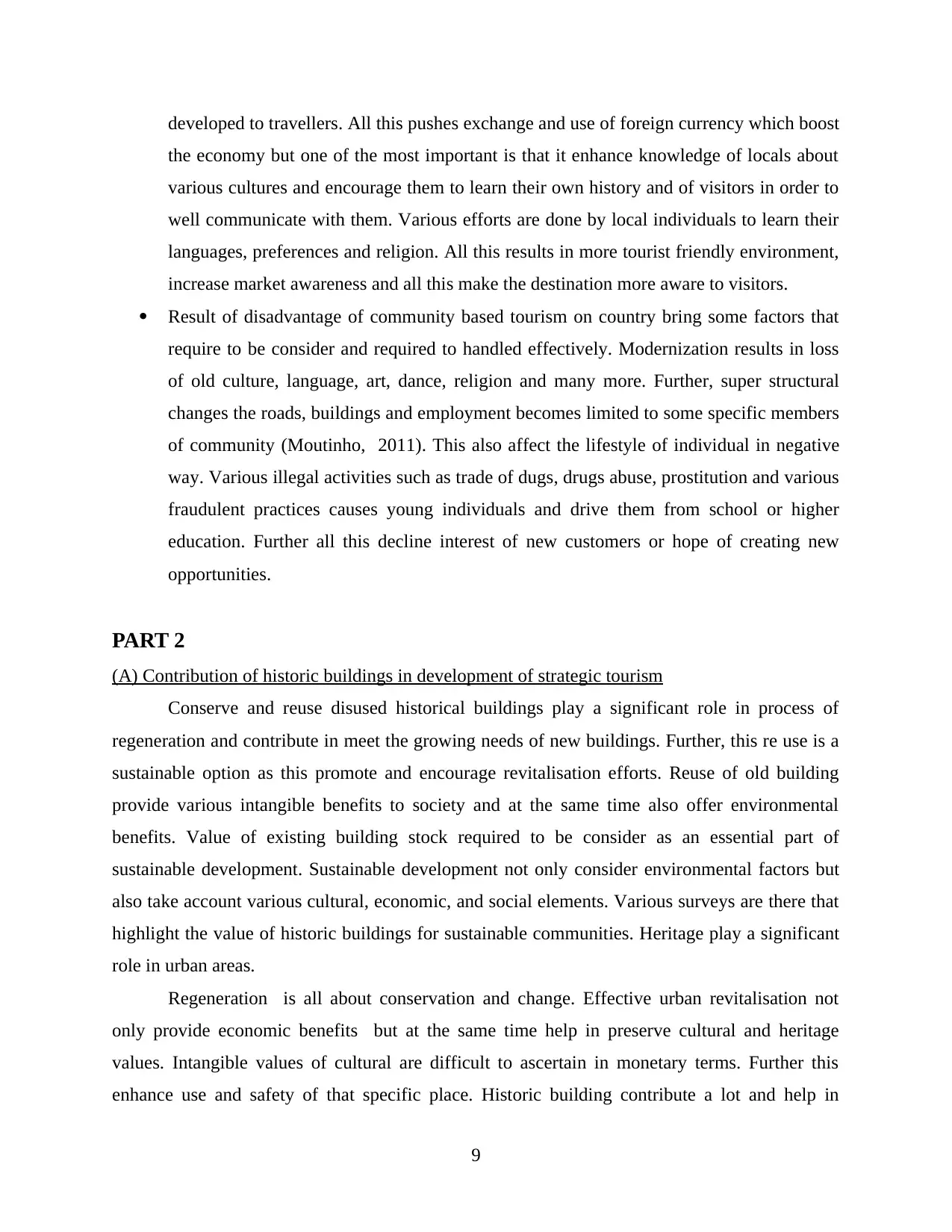
developed to travellers. All this pushes exchange and use of foreign currency which boost
the economy but one of the most important is that it enhance knowledge of locals about
various cultures and encourage them to learn their own history and of visitors in order to
well communicate with them. Various efforts are done by local individuals to learn their
languages, preferences and religion. All this results in more tourist friendly environment,
increase market awareness and all this make the destination more aware to visitors.
Result of disadvantage of community based tourism on country bring some factors that
require to be consider and required to handled effectively. Modernization results in loss
of old culture, language, art, dance, religion and many more. Further, super structural
changes the roads, buildings and employment becomes limited to some specific members
of community (Moutinho, 2011). This also affect the lifestyle of individual in negative
way. Various illegal activities such as trade of dugs, drugs abuse, prostitution and various
fraudulent practices causes young individuals and drive them from school or higher
education. Further all this decline interest of new customers or hope of creating new
opportunities.
PART 2
(A) Contribution of historic buildings in development of strategic tourism
Conserve and reuse disused historical buildings play a significant role in process of
regeneration and contribute in meet the growing needs of new buildings. Further, this re use is a
sustainable option as this promote and encourage revitalisation efforts. Reuse of old building
provide various intangible benefits to society and at the same time also offer environmental
benefits. Value of existing building stock required to be consider as an essential part of
sustainable development. Sustainable development not only consider environmental factors but
also take account various cultural, economic, and social elements. Various surveys are there that
highlight the value of historic buildings for sustainable communities. Heritage play a significant
role in urban areas.
Regeneration is all about conservation and change. Effective urban revitalisation not
only provide economic benefits but at the same time help in preserve cultural and heritage
values. Intangible values of cultural are difficult to ascertain in monetary terms. Further this
enhance use and safety of that specific place. Historic building contribute a lot and help in
9
the economy but one of the most important is that it enhance knowledge of locals about
various cultures and encourage them to learn their own history and of visitors in order to
well communicate with them. Various efforts are done by local individuals to learn their
languages, preferences and religion. All this results in more tourist friendly environment,
increase market awareness and all this make the destination more aware to visitors.
Result of disadvantage of community based tourism on country bring some factors that
require to be consider and required to handled effectively. Modernization results in loss
of old culture, language, art, dance, religion and many more. Further, super structural
changes the roads, buildings and employment becomes limited to some specific members
of community (Moutinho, 2011). This also affect the lifestyle of individual in negative
way. Various illegal activities such as trade of dugs, drugs abuse, prostitution and various
fraudulent practices causes young individuals and drive them from school or higher
education. Further all this decline interest of new customers or hope of creating new
opportunities.
PART 2
(A) Contribution of historic buildings in development of strategic tourism
Conserve and reuse disused historical buildings play a significant role in process of
regeneration and contribute in meet the growing needs of new buildings. Further, this re use is a
sustainable option as this promote and encourage revitalisation efforts. Reuse of old building
provide various intangible benefits to society and at the same time also offer environmental
benefits. Value of existing building stock required to be consider as an essential part of
sustainable development. Sustainable development not only consider environmental factors but
also take account various cultural, economic, and social elements. Various surveys are there that
highlight the value of historic buildings for sustainable communities. Heritage play a significant
role in urban areas.
Regeneration is all about conservation and change. Effective urban revitalisation not
only provide economic benefits but at the same time help in preserve cultural and heritage
values. Intangible values of cultural are difficult to ascertain in monetary terms. Further this
enhance use and safety of that specific place. Historic building contribute a lot and help in
9
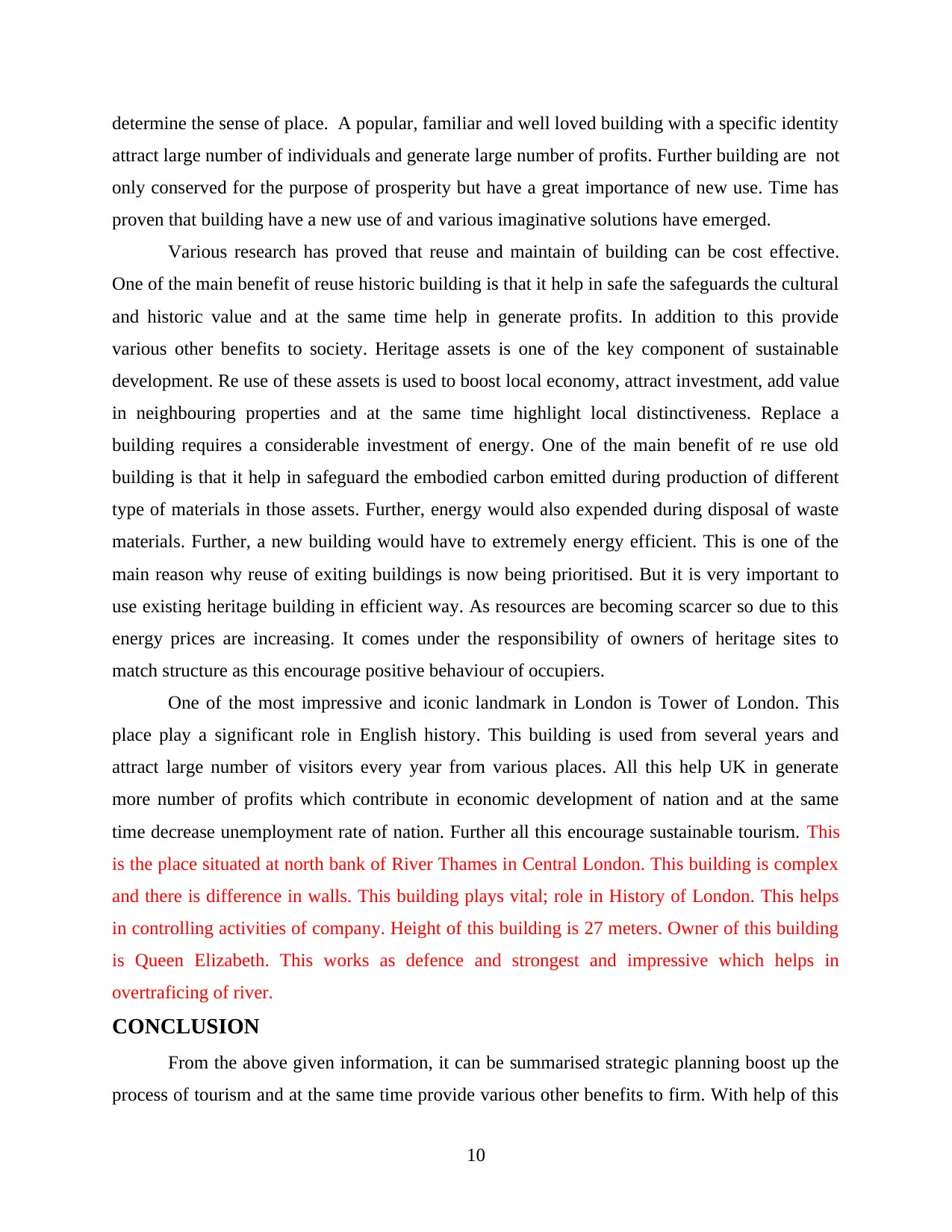
determine the sense of place. A popular, familiar and well loved building with a specific identity
attract large number of individuals and generate large number of profits. Further building are not
only conserved for the purpose of prosperity but have a great importance of new use. Time has
proven that building have a new use of and various imaginative solutions have emerged.
Various research has proved that reuse and maintain of building can be cost effective.
One of the main benefit of reuse historic building is that it help in safe the safeguards the cultural
and historic value and at the same time help in generate profits. In addition to this provide
various other benefits to society. Heritage assets is one of the key component of sustainable
development. Re use of these assets is used to boost local economy, attract investment, add value
in neighbouring properties and at the same time highlight local distinctiveness. Replace a
building requires a considerable investment of energy. One of the main benefit of re use old
building is that it help in safeguard the embodied carbon emitted during production of different
type of materials in those assets. Further, energy would also expended during disposal of waste
materials. Further, a new building would have to extremely energy efficient. This is one of the
main reason why reuse of exiting buildings is now being prioritised. But it is very important to
use existing heritage building in efficient way. As resources are becoming scarcer so due to this
energy prices are increasing. It comes under the responsibility of owners of heritage sites to
match structure as this encourage positive behaviour of occupiers.
One of the most impressive and iconic landmark in London is Tower of London. This
place play a significant role in English history. This building is used from several years and
attract large number of visitors every year from various places. All this help UK in generate
more number of profits which contribute in economic development of nation and at the same
time decrease unemployment rate of nation. Further all this encourage sustainable tourism. This
is the place situated at north bank of River Thames in Central London. This building is complex
and there is difference in walls. This building plays vital; role in History of London. This helps
in controlling activities of company. Height of this building is 27 meters. Owner of this building
is Queen Elizabeth. This works as defence and strongest and impressive which helps in
overtraficing of river.
CONCLUSION
From the above given information, it can be summarised strategic planning boost up the
process of tourism and at the same time provide various other benefits to firm. With help of this
10
attract large number of individuals and generate large number of profits. Further building are not
only conserved for the purpose of prosperity but have a great importance of new use. Time has
proven that building have a new use of and various imaginative solutions have emerged.
Various research has proved that reuse and maintain of building can be cost effective.
One of the main benefit of reuse historic building is that it help in safe the safeguards the cultural
and historic value and at the same time help in generate profits. In addition to this provide
various other benefits to society. Heritage assets is one of the key component of sustainable
development. Re use of these assets is used to boost local economy, attract investment, add value
in neighbouring properties and at the same time highlight local distinctiveness. Replace a
building requires a considerable investment of energy. One of the main benefit of re use old
building is that it help in safeguard the embodied carbon emitted during production of different
type of materials in those assets. Further, energy would also expended during disposal of waste
materials. Further, a new building would have to extremely energy efficient. This is one of the
main reason why reuse of exiting buildings is now being prioritised. But it is very important to
use existing heritage building in efficient way. As resources are becoming scarcer so due to this
energy prices are increasing. It comes under the responsibility of owners of heritage sites to
match structure as this encourage positive behaviour of occupiers.
One of the most impressive and iconic landmark in London is Tower of London. This
place play a significant role in English history. This building is used from several years and
attract large number of visitors every year from various places. All this help UK in generate
more number of profits which contribute in economic development of nation and at the same
time decrease unemployment rate of nation. Further all this encourage sustainable tourism. This
is the place situated at north bank of River Thames in Central London. This building is complex
and there is difference in walls. This building plays vital; role in History of London. This helps
in controlling activities of company. Height of this building is 27 meters. Owner of this building
is Queen Elizabeth. This works as defence and strongest and impressive which helps in
overtraficing of river.
CONCLUSION
From the above given information, it can be summarised strategic planning boost up the
process of tourism and at the same time provide various other benefits to firm. With help of this
10
⊘ This is a preview!⊘
Do you want full access?
Subscribe today to unlock all pages.

Trusted by 1+ million students worldwide
1 out of 14
Related Documents
Your All-in-One AI-Powered Toolkit for Academic Success.
+13062052269
info@desklib.com
Available 24*7 on WhatsApp / Email
![[object Object]](/_next/static/media/star-bottom.7253800d.svg)
Unlock your academic potential
Copyright © 2020–2025 A2Z Services. All Rights Reserved. Developed and managed by ZUCOL.




